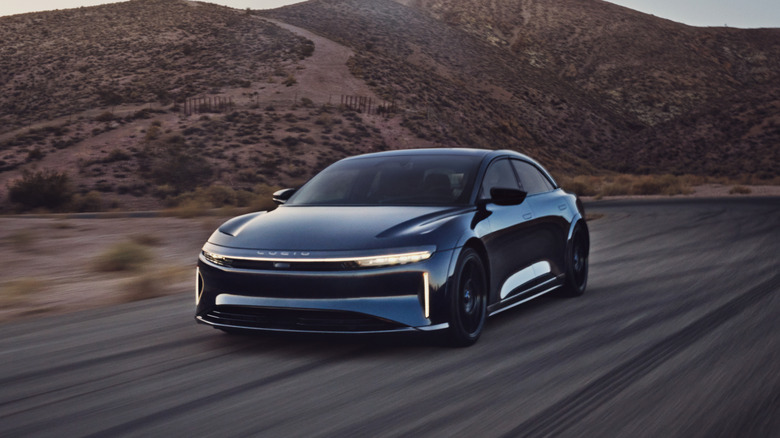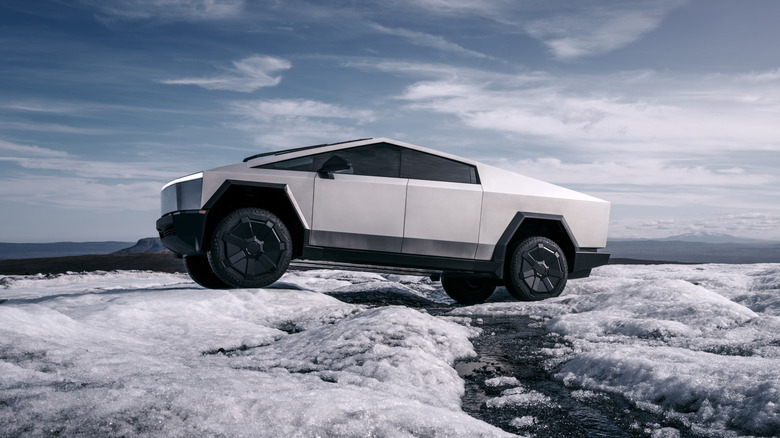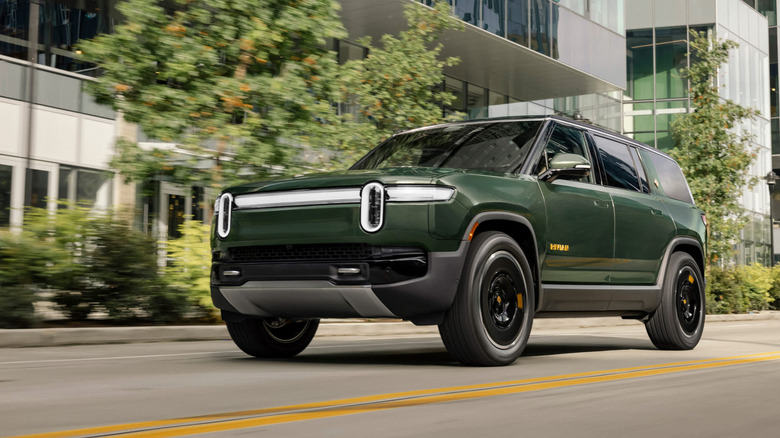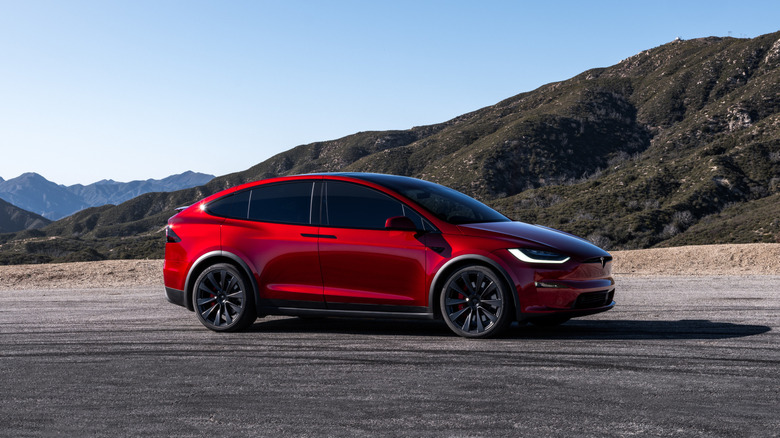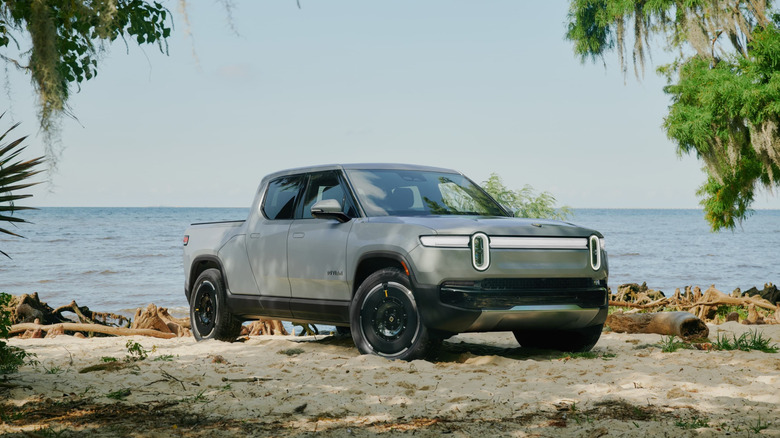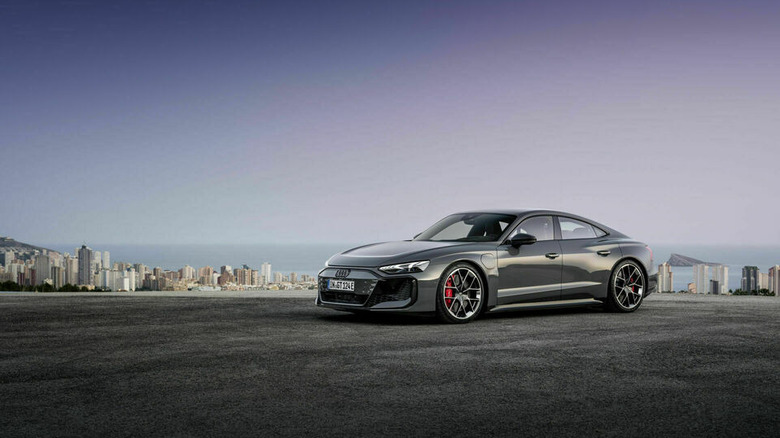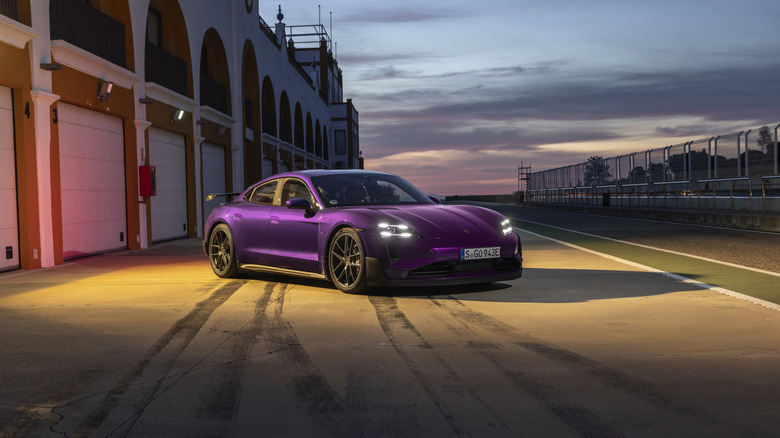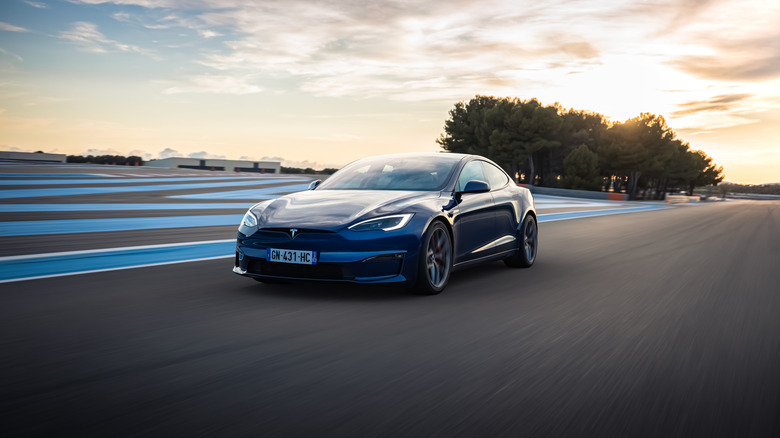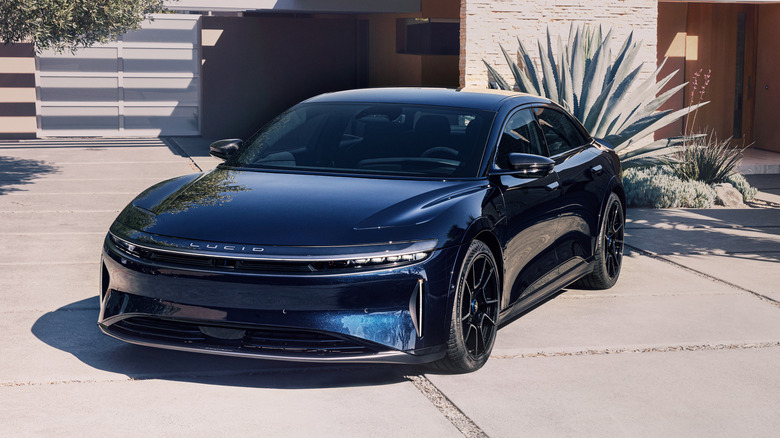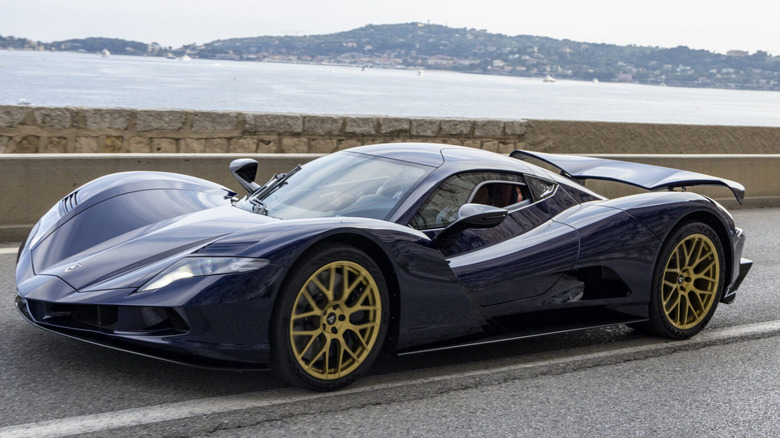10 Of The Fastest Accelerating Electric Cars, Ranked By 0-60 Times
We have entered a new automotive age. In the past, the lists of the fastest and quickest-accelerating cars were dominated by V8-powered muscle cars or mid-engine exotic supercars with 12 cylinders screaming right behind the driver's ears. Whether they came from Detroit, Italy, or elsewhere, they had one thing in common in the smell of combusted gasoline coming from their tailpipes. But that has changed. Many of today's fastest cars, including many of the fastest-accelerating cars, are powered by batteries. And some aren't even cars, but rather pickup trucks or SUVs.
Why are electric vehicles so incredibly quick to 60 mph from a standing start, even though some of them weigh over three tons? Chalk it up to torque. Even though the electric motors in EVs are generally smaller than gasoline engines, they generate huge amounts of torque. Plus, they offer this torque from zero mph, delivering consistent acceleration all the way to their performance limits. By comparison, internal combustion-powered cars must rev up to peak torque. In addition, many EVs have electric motors on both the front and rear axles, delivering instant power directly to all four wheels.
This results in 0-60 and quarter-mile times approaching the limits of what's mechanically possible. With so much torque on hand, EVs don't need to be small or sleek to achieve mind-bending performance numbers. Several of the vehicles on the following list are sedans, SUVs, and pickups. As electrification spreads, EVs will continue to change the performance car world for the better.
10. 2025 Tesla Cybertruck Cyberbeast
The Tesla Cybertruck is probably the most attention-getting vehicle on our list. Indeed, it's possibly one of the most attention-getting automobiles of all time — but it's not just about its wild, stainless-steel exterior. In its Cyberbeast trim, it can do the 0-60 run in only 2.6 seconds despite weighing over 6,800 pounds. It can also tow as well as a diesel pickup, and in one Tesla publicity event, a Cybertruck Cyberbeast even beat a Porsche 911 in a quarter-mile race while towing another 911. Top speed is a relatively low 130 mph, showing the limits of the wedge-shaped pickup's aerodynamics.
A 2025 Cyberbeast generates 845 horsepower. Torque numbers are a little harder to pin down since sources give different numbers, but there's enough torque to tow 11,000 pounds, according to Tesla's website. To get supercar acceleration and a heavy-duty tow rating, the Cyberbeast relies on an all-wheel-drive, tri-motor setup. This gives it more power and torque than the dual-motor base Cybertruck. Driving range is estimated at 320 miles, with quick charging on a Tesla Supercharger adding 130 miles of range in only 15 minutes. An upcoming range extender will boost its range to 415 miles.
The Cyberbeast functions well as a pickup truck. In addition to its 11,000-pound tow rating, it offers a 6-foot-long, 67-cubic-foot bed and a 2,500-pound payload. There's also that allegedly bulletproof steel exterior, although whether the Cybertruck is really bulletproof depends partly on how you define the word. One thing is sure, though: Due to the limitations of its tires and suspension, the Cybertruck is not the best off-road vehicle.
9. 2025 Rivian R1S Quad Motor
Rivian is a relative newcomer that has quickly staked a claim as a builder of some of the best and fastest EV trucks on the planet. Its R1S Quad Motor SUV can thunder from 0 to 60 in just 2.6 seconds, tying it with the Cyberbeast. As its name implies, it accomplishes this with a four-motor setup, with each 256-horsepower motor contributing to a total horsepower rating of 1,025. Torque is equally impressive at 1,198 lb-ft. All of this power helps to get the R1S Quad Motor's 6,824-pound mass through the quarter-mile in only 10.5 seconds at an amazing 128 mph. Remember: This is a seven-passenger SUV! Yet it could smoke most Ferraris, Lamborghinis, and McClarens on a drag strip.
The R1S sports a motor at each wheel receiving power from a 149-kWh battery pack. This gives it all-wheel drive grip for blindingly quick launches and all-weather safety, but this arrangement does more than that. With no differentials or transmissions between the motors and the axles, the R1S continuously adjusts power delivery to each wheel in response to driving maneuvers for maximum grip. This gives it handling that you would never expect from a three-and-a-half-ton SUV. Furthermore, the R1S's adaptive air suspension eliminates body roll in corners, giving it race-car-like handling. The suspension also combines with multiple off-road modes to win the R1S a spot on our list of best off-road vehicles.
8. 2025 Tesla Model X Plaid
In the Model X's Plaid trim, Tesla's quirky SUV can zoom from 0 to 60 in only 2.5 seconds, setting it ahead of its Cyberbeast cousin and the R1S, although barely. Still, this insanely fast acceleration befits the Plaid name, which refers to the beyond-faster-than-light speed achieved by the titular starship in the 1980s screwball sci-fi parody, "Spaceballs." The Plaid version of the Model X uses three motors to generate 1,020 horsepower and 1,050 lb-ft of torque. The 2025 Model X Plaid is priced at $101,630, or about $15,000 more than the base Model X. For that price, buyers get an estimated driving range of 326 miles along with its amazing performance.
With one engine powering the front axle and two in the rear, the Plaid model offers all-wheel drive. An optional third row of seats increases seating to six or seven, with the rear seats accessed via powered gull-wing doors while the front doors open conventionally. The rear doors boost the Model X's quirkiness factor, along with its high-tech features that include a gigantic touchscreen infotainment screen, a digital gauge cluster, and screens for rear-seat passengers. Being a Tesla, it comes with the Autopilot feature, which can be upgraded to Full Self-Driving mode.
7. 2025 Rivan R1T Quad Max
The Rivian R1T Quad Max can win at the drag strip with its 2.5-second 0-60 time and then turn around and drive up a mountain. That has always been its mission statement, but the R1T has been around long enough for a redesign, albeit under the sheet metal, as the exterior remains the same. Yet now it offers even more of what made it great in the first place. This includes a motor driving each wheel, giving the R1T 1,025 horsepower and 1,198 lb-ft of torque. This setup powers the R1T through the quarter mile in only 10.4 seconds at 128.6 mph while also contributing to grip that's good for a skidpad figure of 0.91 g. Once upon a time, only sports cars had that kind of grip, never mind pickup trucks weighing just shy of 6,900 pounds.
But speed isn't the R1T's only strong suit. This truck is a high-tech powerhouse on wheels. In February of 2025, Rivian announced a hands-free driving update via its over-the-air software updates, erasing one of the last areas in which the R1T trailed its Tesla Cybertruck rival. Rivian has also used software updates to shorten charging times, update its parking assistance feature, and more. All of this is in addition to smart physical features like the lockable gear tunnel under the pickup bed. Its interior is furnished with beautiful materials like real wood. For an upstart carmaker, Rivian offers an impressively intelligent and well-designed truck.
6. 2025 Audi RS e-tron GT Performance
Audi's RS e-tron GT Performance sedan delivers on its low, wide, and sinister looks with a 0-62 mph time of 2.5 seconds. The 2025 model improves on an already impressive package with better batteries, improved all-wheel drive systems, and some redesigned exterior elements, such as the grille. The Performance trim level delivers 912 horsepower and 757 lb-ft of torque. As with many German cars, top speed is limited to 155 mph by a governor.. The Performance trim level of the RS e-tron GT offers the most performance, range, and power at $168,295.
All e-Tron GT models use a dual-motor all-wheel drive setup to achieve maximum grip for launching under any road conditions. In the Performance model, the front motor uses a modified pulse inverter to achieve higher performance than other trims. The Performance achieves its peak of 912 horsepower via a ten-second overboost function. Under normal driving, it generates 818 horsepower, which most drivers would probably consider quite adequate. A new battery pack is 22 pounds lighter than in previous model years, yet it offers 97.0 kWh, up from 83.7 kWh. Other improvements include faster charging times and larger brakes to bring the car's 5,200 pounds of mass to a quick stop. And being an Audi, it offers a sumptuous interior trimmed with materials like birch.
5. 2025 Porsche Taycan Turbo GT with Weissach Package
This Porsche Taycan Turbo GT's full model name is a mouthful, but with the Weissach Package, this sedan version of the Taycan tears off a 2.1-second 0-60 time. It may take longer to say the car's name than it does to get to highway speed. The Weissach Package isn't just a vanity trim level, either. It's so committed to speed that it even deletes the back seat to save weight, creating the odd sight of a four-door sedan with no rear seating. (A storage bin replaces it.) It also ditches the driver's side charging port, rear stereo speakers, and other items to get down to fighting weight. This helped the Taycan Turbo GT Weissach to set an electric performance record at the track in Laguna Seca, California.
Combine that with a peak horsepower rating of 1,092 along with 988 lb-ft of torque routed through front and rear motors to power all four wheels, and the Taycan Turbo GT in this trim can sprint a quarter mile in as little as 9.3 seconds. A liquid-cooled battery keeps things from overheating during strenuous track driving. Specially developed steering wheel paddles offer access to the overboost control. It takes only 18 minutes to charge the large 97.0 kWh battery pack up to 80%, so even off the track, this Taycan is speedy.
4. 2025 Tesla Model S Plaid
With a 2.1-second 0-60 time, the Tesla Model S Plaid is the standard-bearer for Tesla's ludicrously quick EVs. The quarter mile comes up in just 9.4 seconds at 151 mph on the way to a speed governor-limited top speed of 162 mph. And if sheer velocity isn't enough for you, the Model S Plaid offers 1.08 g of skidpad grip, meaning you'll be pulled harder sideways through a curve than you're pulled down by Earth's gravity. And all of this performance is found in an EV that first went on sale in mid-2012. Tesla has done a commendable job of keeping the Model S's mechanical bits up to date. And it's practical, too, being a five-door sedan with a hatchback.
The Plaid flavor of the Model S derives its performance from a 1,020 horsepower three-motor setup with one in front and two in the rear, delivering power to both axles for all-wheel drive. Its range is a very decent 348 miles with the smaller of the two available wheel sizes, although it drops to 312 miles with larger wheels. Like most other Teslas, it comes with Autopilot driver-assist features, which can be boosted to Full Self-Driving mode with a software upgrade. The Model S Plaid costs around $96,000, about 15 grand more than the base Model S.
3. 2025 Lucid Air Sapphire
Lucid has been challenging Tesla and other high-performance EV makers since its launch a few years ago, producing beautiful sedans with whiplash-inducing acceleration. Lucid claims its Sapphire model can hit 60 mph from a standstill in 1.9 seconds. Lucid's nomenclature can be a bit confusing: Air refers to its sedans, as opposed to its Gravity family of SUVs. Sapphire is the highest-performance variant of the Air sedan, and Lucid often refers to it as the Air Sapphire. The car is as alluring as its jeweled name, being simultaneously sleek and beautiful. But what's under the sheet metal gives the Air Sapphire its top speed of 205 mph and a range of 427 miles. It's priced just one grand shy of a cool quarter million.
With 1,234 horsepower and a positively mind-bending 1,430 lb-ft of torque, the Air Sapphire claimed the title of the quickest sedan on Earth from Tesla's Model S Plaid. Yet, performance is just one of the reasons the Wall Street Journal called the Air Sapphire "unquestionably one of the finest sedans in history." Unlike some more spartan EVs, the interior swaddles its occupants in luxury, including sport seats with heating, cooling, and massage functions. The spacious cabin is trimmed in luxurious materials like leather. The user interface on its touchscreen LCD is one of the most intuitive the Wall Street Journal has ever reviewed. Technology and aesthetics make the Air Sapphire a champ in almost every dimension.
2. 2025 Rimac Nevera
You might associate Croatia more with filming locations for Game of Thrones than cutting-edge hypercars, but this stunning EV from the Balkan nation is real and can go from 0 to 60 mph in 1.74 seconds. A first look at the Rimac Nevera reveals a car that resembles traditional supercars more closely than the sedans, pickups, and SUVs that we've looked at so far. Yet what's under the Nevera's low-slung, McLaren-like body places it firmly on the leading edge of automotive technology. With four motors drawing power from a 108-kWh battery pack, the 2025 Nevera produces 2,107 horsepower. That's not a typo: This car shatters the 2,000 horsepower barrier.
That's good enough for a quarter-mile time of 8.23 seconds and a top speed of 256 mph. Its batteries use lithium nickel cobalt manganese oxide technology, which not only offers more power but also prevents overheating during racing. The Nevera is no boulevard cruiser, but rather a serious track-focused performance machine. Torque vectoring and a revised steering setup improve handling compared with previous models. A sophisticated suspension enables wheel arches that fit tightly over the tires for a lower stance. This demonstrates how every detail of the Nevera is calculated to make it one of the fastest cars on Earth.
1. 2021+ Aspark Owl
Our fastest-accelerating electric car is a Japanese-designed, Italian-built hypercar with a troubled development history. Yet the Aspark Owl finally went on sale in North America and Europe a few years ago, turning its 1.72-second 0-60 time into a production car reality. It also set two Guinness World Records for the fastest eighth-mile and quarter-mile speeds for a production electric car at 192 mph and 198 mph, respectively. These nearly unbelievable speeds were hit on the way to a top speed of 260 mph. This space-warping performance comes at a true hypercar price of $3.56 million, but Aspark hopes to sell 50 units.
Aspark is an engineering firm located in Osaka, Japan, with offices in 25 countries. It offers engineering services to other companies while developing its home-grown hypercar. The Owl is assembled at Manifattura Automobili Torino in Turin, Italy. Aspark's website claims the Owl generates 1,980 horsepower. In October of 2024, Aspark demonstrated a prototype for the next model of the Owl called the Owl SP600. This version reached 273 mph, which would solidify its claim to be the world's fastest EV if these numbers transfer to a production model. Guinness has already certified it as the "fastest battery-powered electric prototype hypercar in the world."
